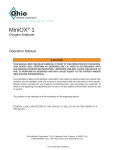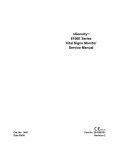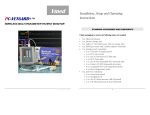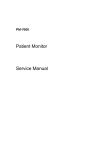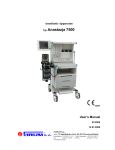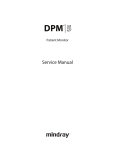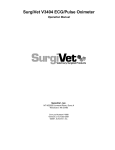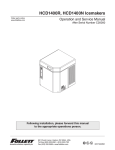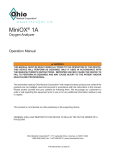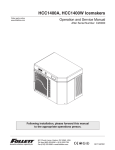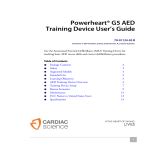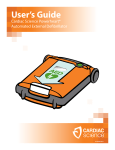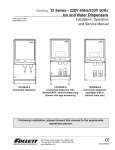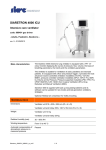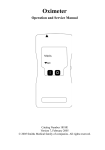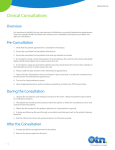Download Poet®IQ 8500H Agent Gas Analyzer Operator`s
Transcript
Poet® IQ 8500H Agent Gas Analyzer Operator’s Manual Cat. No. 2215 Date 11/10 Part No. 39198B001 Revision 2 Copyright COPYRIGHT © CRITICARE SYSTEMS, INC., 2009–2010 CRITICARE SYSTEMS, INC. (Criticare) owns all rights to this unpublished work and intends to maintain this work as confidential. Criticare may also seek to maintain this work as an unpublished copyright. This publication is to be used solely for the purposes of reference, operation, maintenance, or repair of Criticare equipment. No part of this publication may be reproduced in any manner or disseminated for other purposes. In the event of inadvertent or deliberate publication, Criticare intends to enforce its rights to this work under copyright laws as a published work. Those having access to this work may not copy, use, or disclose the information in this work unless expressly authorized by Criticare to do so. All product specifications, as well as information contained in this publication, are subject to change without notice. All information contained in this publication is believed to be correct. Criticare Systems, Inc., shall not be liable for errors contained herein nor for incidental or consequential damages in connection with the furnishing, performance, or use of this material. This publication may refer to information and products protected by copyrights or patents and does not convey any license under the patent rights of Criticare Systems, Inc., nor the rights of others. Criticare Systems, Inc., does not assume any liability arising out of any infringements of patents or other rights of third parties. PROPERTY OF CRITICARE SYSTEMS, INC. ALL RIGHTS RESERVED High IQTM is a trademark. WaterChek® and Poet® are registered trademarks of Criticare Systems, Inc. Page ii Poet® IQ 8500H Operator’s Manual Criticare Systems, Inc. Contents Copyright................................................................................................................ii Contents................................................................................................................ iii Warranty............................................................................................................... vii Service Return Policy.......................................................................................... viii EC Declaration of Conformity................................................................................ix Section 1: Introduction Description .................................................................................................................... 1-1 Intended Use................................................................................................................. 1-1 Integrated CO2 and Agent Gas Detector ...................................................................... 1-1 Capnometry (Measurement of CO2) .................................................................. 1-1 Agent Gas Measurement ................................................................................... 1-2 Conditions of Use............................................................................................... 1-2 Stability of Accuracy........................................................................................... 1-3 Agent Accuracy of Measurement ....................................................................... 1-3 Oxygen (O2) Measurement ........................................................................................... 1-3 Method ............................................................................................................... 1-3 Conditions of Use............................................................................................... 1-4 Stability of Accuracy........................................................................................... 1-4 Specifications................................................................................................................ 1-5 Symbols ........................................................................................................................ 1-8 Safety............................................................................................................................ 1-9 Warnings ............................................................................................................ 1-9 Cautions ............................................................................................................. 1-9 Leakage Current .............................................................................................. 1-10 Voltage Fluctuations......................................................................................... 1-10 Software Error Related Hazard Mediation ....................................................... 1-10 Potential Interference ....................................................................................... 1-10 Biocompatibility ................................................................................................ 1-11 Latex Content................................................................................................... 1-11 DEHP Content.................................................................................................. 1-11 Section 2: Controls and Connections Poet® IQ 8500H Series Gas Analyzer.......................................................................... 2-1 Front Panel......................................................................................................... 2-1 Rear Panel ......................................................................................................... 2-2 Section 3: Setup Procedure Monitor Setup................................................................................................................ 3-1 Auto-calibration and Warm Up ........................................................................... 3-1 Primary Agent Selection..................................................................................... 3-1 Flow Rate Setting............................................................................................... 3-2 Zero Calibration Request ................................................................................... 3-2 N2O Compensation ............................................................................................ 3-3 Criticare Systems, Inc. Poet IQ™ 8500H Operator’s Manual Page iii Contents Section 4: Patient Monitoring Introduction to Clinical Use............................................................................................4-1 Before you Begin ................................................................................................4-1 Gas Monitoring Safety ........................................................................................4-2 Water Trap Connections.....................................................................................4-3 Startup and Calibration.......................................................................................4-3 Procedure for Gas Monitoring .......................................................................................4-4 Placement of Nasal Cannula ..............................................................................4-5 Intubated Patients...............................................................................................4-5 Ventilation Circuit Adapters ................................................................................4-5 Occlusions ..........................................................................................................4-6 Anesthetic Gas Monitoring ............................................................................................4-7 Anesthetic Agent Identification and Quantification .............................................4-7 Primary Agent.....................................................................................................4-7 User Selected Primary Agent .............................................................................4-7 Automatic Primary Agent Detection....................................................................4-8 Secondary Agent Detection................................................................................4-8 Agent Identification Thresholds ..........................................................................4-8 Interfering Gases For Anesthetic Agents............................................................4-9 CO2 Monitoring (Capnometry).....................................................................................4-12 Oxygen (O2) Monitoring ..............................................................................................4-13 Measurement Accuracy...............................................................................................4-14 Measurement Accuracy for Gas Mixtures ...................................................................4-15 Drift of Measurement Accuracy ...................................................................................4-16 Section 5: Alarms and Messages Alarm Description ..........................................................................................................5-1 Alarm and Message List................................................................................................5-1 Respiration Alarms and Messages.....................................................................5-1 Capnometry (CO2) Alarms and Messages .........................................................5-1 Agent Gas Alarms and Messages ......................................................................5-2 Oxygen Monitoring (O2) Alarms and Messages .................................................5-4 Section 6: Maintenance Cleaning and Disinfecting..............................................................................................6-1 Accidental Wetting.........................................................................................................6-1 Testing and Calibration .................................................................................................6-2 Annual Safety Tests ......................................................................................................6-2 Service Checks...................................................................................................6-2 Maintenance Schedule..................................................................................................6-2 3 Month O2 Drift Check .................................................................................................6-3 Equipment Needed.............................................................................................6-3 O2 Drift Check ....................................................................................................6-3 Expendable Components ..............................................................................................6-4 Long-Term Storage .......................................................................................................6-4 Disposal.........................................................................................................................6-4 Page iv Poet IQ™ 8500H Operator’s Manual Criticare Systems, Inc. Contents Appendix A: Accessories Gas Monitoring Accessories .........................................................................................A-1 Sampling Devices ..............................................................................................A-1 Gas Testing Accessories ...................................................................................A-1 Gas Testing Kits.................................................................................................A-2 Publications...................................................................................................................A-2 Operator’s Manuals............................................................................................A-2 Service Manuals.................................................................................................A-2 Appendix B: Connecting with nCompass™ 8100H Series Patient Monitor Criticare Systems, Inc. Poet IQ™ 8500H Operator’s Manual Page v Warranty Workmanship & Materials Criticare Systems, Inc. (CSI) warranties new equipment to be free from defects in workmanship and materials for a period of two (2) years from date of shipment under normal use and service. The following exceptions apply to this statement and the warranty period as indicated: Internal Batteries: one (1) year O2 Cells and CO2 Absorbers: six (6) months Y Style SpO2 Sensors: six (6) months CSI’s obligation under this warranty is limited to repairing or replacing, at CSI’s option, any part which upon CSI’s examination proves defective. EXCEPT AS DESCRIBED IN THE PARAGRAPH ABOVE, CSI MAKES NO WARRANTIES, EXPRESS OR IMPLIED, INCLUDING ANY WARRANTY OF MERCHANTABILITY OR FITNESS FOR A PARTICULAR PURPOSE. Exemptions CSI’s obligation or liability under this warranty does not include any transportation or other charges or liability for direct, indirect or consequential damages or delay resulting from the improper use or application of the product or the substitution upon it of parts or accessories not approved by CSI or repair by anyone other than a CSI authorized representative. This warranty shall not extend to any instrument which has been subjected to misuse, negligence or accident; any instrument from which CSI’s original serial number tag or product identification markings have been altered or removed; or any product of any other manufacturer. Safety, Reliability & Performance Criticare Systems, Inc., is not responsible for the effects on safety, reliability and performance of the 8500H Agent Gas Analyzer if: assembly operations, extensions, readjustments, modifications or repairs are carried out by persons other than those authorized by Criticare Systems, Inc., or the 8500H Agent Gas Analyzer is not used in accordance with the instructions for use, or the electrical installation of the relevant room does not comply with NFPA 70: National Electric Code or NFPA 99: Standard for Health Care Facilities (Outside the United States, the relevant room must comply with all electrical installation regulations mandated by the local and regional bodies of government). In Case of Emergency Contact CRITICARE SYSTEMS, INC. N7 W22025 Johnson Drive Waukesha, WI 53186 USA Telephone: (262) 798-8282 Tech Support: (800) 458-2697 Orders: (800) 458-4615 Fax: (262) 798-8290 Internet: www.csiusa.com Criticare Systems, Inc. Poet® IQ 8500H Operator’s Manual Page vii Service Return Policy Return Procedure In the event that it becomes necessary to return a unit to Criticare Systems, Inc., the following procedure should be followed: Obtain return authorization. Contact the CSI Service Department at 800-458-2697 to obtain a Customer Service Authorization (CSA) number. (Outside the US, call 001-262-798-8282.) The CSA number must appear on the outside of the shipping container. Return shipments will not be accepted if the CSA number is not clearly visible. Please provide the model number, serial number, and a brief description of the reason for return. Freight policy. The customer is responsible for freight charges when equipment is shipped to CSI for service (this includes customs charges). Loaner service. In the U.S. If it is necessary to provide a loaner unit to any U.S. customer, CSI will ship the unit within one (1) working day, if available, by secure transport means. For units under warranty, a loaner unit (if required) will be made available upon request. For unit out of warranty, in the event of a loaner unit being required after the product warranty has expired and no extended service contract is in place, a charge will be applied to the customer’s account. Loaner units must be returned to CSI at the customer’s expense within one (1) week after receipt of the repaired goods. If the unit is not returned within that time, the customer will be invoiced for the full purchase price of the equipment. Outside the U.S. No loaners are available from CSI internationally. Contact your local CSI representative. Page viii Poet® IQ 8500H Operator’s Manual Criticare Systems, Inc. EC Declaration of Conformity Poet® IQ 8500H Agent Gas Analyzer Representative in the European Union Criticare Systems, Inc. To view the Declaration of Conformity, visit the Criticare website at www.csiusa.com. A copy of the Declaration can also be faxed. Contact Criticare’s customer service department at (262) 798-8282 to obtain a faxed copy of the Declaration. MDSS GmbH Schiffgraben 41 30175 Hannover Germany Poet® IQ 8500H Operator’s Manual Page ix Section 1 — Introduction Description The 8500H agent gas analyzer measures real time concentrations of anesthetic agent gases. The device measures gases using a sidestream method. The primary module measures concentrations of CO2, N2O, and halogenated anesthetic agents. The device can also measure oxygen concentrations using a galvanic cell. Intended Use The 8500H analyzer is intended to be used with an approved host monitoring system with the appropriate software or software upgrades. Follow supplier’s instructions for compatibility and operating instructions. The 8500H analyzer (with a host monitor) is designed to monitor physiological parameters of patients within clinical care settings. The 8500H analyzer with host monitor is intended to monitor concentrations of halothane, enflurane, isoflurane, sevoflurane, and desflurane during anesthetic surgery. The user is responsible for the interpretation of the monitored data that is made available. It is intended that the user is a professional health care provider. Physiological data, system alarms, and patient data analysis are available to the care provider from the host monitor. The analyzer is designed to be used with only one patient at a time. Integrated CO2 and Agent Gas Detector The primary hardware module of the 8500H analyzer is an integrated CO2/agent detector (bench). The integrated detector measures carbon dioxide (CO2), nitrous oxide (N2O), and five halogenated anesthetic agent gases using the same sample collection path and testing apparatus. The analyzer uses proprietary High IQ™ technology to identify and quantify agent gases. There are no moving parts, reducing size of the detector and enhancing reliability. The 8500H analyzer uses the sidestream method of measuring CO2 and anesthetic agent gases. Gas is drawn through a nasal cannula or endotracheal adapter. The gas sample enters the monitor from a sampling tube into a water trap, which removes water vapor and particulate matter from the gas sample. The gas then enters the CO2 (agent) detector where it is analyzed. Capnometry The analyzer measures CO2 concentrations and sends data suitable (Measurement of CO2) for continuous waveform display. The analyzer also detects end-tidal and fractional Inspired CO2 levels, sending the data to the monitor where it is displayed numerically. End-tidal CO2 (EtCO2) is defined as the maximum CO2 concentration at the end of expiration. The analyzer measures the CO2 concentration and the monitor displays the numerical value. The EtCO2 value is updated continuously with each breath cycle. The amount of CO2 in the gas mixture inhaled by the patient is the Fractional Inspired CO2 (FICO2). Criticare Systems, Inc. Poet® IQ 8500H Operator’s Manual Page 1-1 Section 1 —Introduction The analyzer measures CO2 using the principles of infrared absorption spectrometry. An unknown concentration of gas (CO2) is calculated by comparing its absorption of infrared light to that of a known standard. The absorption of light is directly related to the concentration of the gas. As infrared light passes through the sample gas chamber, the light transmitted is converted to a voltage signal. The analyzer converts the voltage into CO2 concentration data that can be expressed numerically or as waveforms by the monitor. The Beer's Law calculation is performed by the software of the external 8500H module. Infrared analysis of the gas samples is done using Beer’s Law. The formula for Beer’s Law is as follows: I = I0 e – ε ( λ )cd I I0 e Infrared value of measured sample. Infrared value of light source. Exponential function. ε( λ ) c d Extinction coefficient. Concentration of the gas sample. Distance measured through the sample. Agent Gas Measurement The agent detector samples gas breathed by the patient through a sidestream circuit. It measures the concentrations of CO2, N2O, and halogenated anesthetic agents in the sampled gas. The detector uses far-infrared measurements to identify concentrations of halothane, enflurane, isoflurane, sevoflurane, desflurane anesthetic agents and their mixtures. The analyzer uses the principles of infrared absorption spectrometry to measure anesthetic gases in the same manner as explained for CO2 measurement. The integrated detector determines the concentrations of anesthetic gases and CO2 by measuring the optical absorption of the sampled patient gas at a number of specific wavelengths in the medium to long-wave infrared region. Conditions of Use The 8500H monitoring system has been calibrated with dry NIST-traceable calibration gases at room temperature and pressure (~ 21C, 740 mmHg). Given the small effect of water vapor on agent gas and CO2 measurements and the system’s built-in temperature and pressure measurements and compensations, this 8500H system method of gas analysis per EN 864 is best described as ATPS (Ambient Temperature and Pressure, Saturated; 21C, 750mmHg, 100% Humidity Saturated). The 8500H monitoring system is suitable for sustained pressure (breathing circuit) monitoring environments and has been tested per Clause 102 (Sustained Pressure) of EN 864. Page 1-2 Poet® IQ 8500H Operator’s Manual Criticare Systems, Inc. Section 1 —Introduction Stability of Accuracy The 8500H analyzer has an internal barometer and thermistor that allow compensation for changes over a range of temperature and atmospheric pressures. The analyzer complies with EN 864 and EN12598 standards for cyclical pressure. Agent Accuracy of The accuracy of a single agent measurement is defined by Measurement the formula, m – ( 0.04 m + 0.1 ) ≤ x ≤ m + ( 0.04 m + 0.1 ) where “m” is equal to the measurement in percent and “x” is the tolerance range. Example of 5% HAL measurement, calculating the high limit of the tolerance range. (5% HAL × 0.04Reading) + 0.1%Absolute = 0.3% 5% HAL + 0.3%Tolerance = 5.3% Final tolerance range is 4.7% to 5.3% HAL. Oxygen (O2) Measurement The 8500H analyzer uses the sidestream method of measuring O2. The gas is sampled from the same gas intake system used for the integrated CO2/agent detector. The shared water trap removes moisture and particulate matter from the gas samples. Method The gas sample is measured using a reactive oxygen cell. The oxygen sensor is a galvanic electrochemical cell that works by a process known as oxidation reduction. Oxygen from the sampled gas comes in contact with a highly reactive metal, reacts with the metal and produces a current. As the oxygen reacts, this reactive metal is gradually being used up. Once the metal is used up, the cell is depleted and can no longer sense oxygen. The cell generates a voltage output proportional to the amount of oxygen in the sampled gas. This oxygen cell has an internal thermistor and circuitry that adjusts the output voltage based on current temperature of the cell. A predictive circuit electronically speeds up the cell response necessary for breath by breath measurements. This voltage is then processed by the microprocessor and displayed to the user. Criticare Systems, Inc. Poet® IQ 8500H Operator’s Manual Page 1-3 Section 1 —Introduction The relationship between gas concentration and pressure is calculated by the microprocessor. The numerical value displayed by the host monitor (O2 Calculated) is generated using the following formula. PC 20.9 O 2 Calculated = O 2 Measured × ------------------------------ × -----O 2Ambient P 0 The measured O2 predictive value is multiplied by a fixed value derived from room pressure divided by room ambient oxygen levels. The measurement is further adjusted by multiplying the ratio of the pressure determined at calibration (PC) with the current pressure (P0). There is a negligible effect on oxygen measurements due to humidity. Conditions of Use The oxygen monitoring feature is appropriate for measuring respiratory O2 concentrations in all patient populations. The oxygen monitor is suitable for use in breathing systems and with the use of inhalation anesthetic agents. Stability of Accuracy The oxygen cell contains temperature correction circuitry. The oxygen sensor temperature is maintained at a nominal 40 degrees Celsius to maintain a consistent performance. Page 1-4 Poet® IQ 8500H Operator’s Manual Criticare Systems, Inc. Section 1 —Introduction Specifications For the 8500H Analyzer when used with a host monitor Capnometry (CO2) Method: Range: Resolution: Accuracy: Flow Rate: Flow Tolerance: Rise Time: Response Time: Time from Cold Stat: Calibration: Units: Display: Sidestream; non-dispersive infrared 0-99 mmHg, 0 to 12.5%, 0 to 12.5 kPa, 0 to 99 Torr 1 mmHg, 0.1%, 0.1 kPa, 1 Torr ±0.2% abs. or 4% of reading for breath rates up to 60 breaths/minute 100, 150, 200 ml/min, user selectable ±10% (10-90%) 350 milliseconds @ 150 ml/min 2.25 seconds 1 minute to first waveforms; <20 minutes to full accuracy Auto-calibrating, Manual Calibration mmHg; Volume Percent; kPa; Torr Inspired CO2, Expired CO2 (End-Tidal) Numerical values, capnograph, and breath by breath EtCO2 bar graph. CO2 Respiration Source: Range: Resolution: Accuracy: Capnogram 1 to 100 breaths/minute 1 breath/minute ± 2 breaths/minute or 2% of reading Nitrous Oxide (N2O) Method: Range: Resolution: Accuracy: Identification Threshold: Rise Time: Response Time: Calibration: Units: Display: Criticare Systems, Inc. Poet® IQ 8500H Operator’s Manual Sidestream; non-dispersive infrared 0 to 99 volume percent 1% ± (1.5% abs. + 4% of reading) for breath rates up to 60 breaths/minute 5% (for single and mixed agents) (10-90%) 400 milliseconds 2.5 seconds Auto-calibrating, Manual Calibration Percent Numerical Inspired N2O, Expired N2O; N2O waveform Page 1-5 Section 1 —Introduction Halogenated Agents Method: Units: Resolution: Range: Accuracy: Identification Threshold: Mixed Gas Threshold: Primary Agent Identification: Mixed Agent Identification: Rise Time: Response Time: Warm-up Time: Calibration: Auto Zeroing: Display: Effect of Interfering Gases: Sidestream; non-dispersive infrared Volume Percent 0.1 Volume Percent Halothane; 0 to 10.0 vol. % Isoflurane; 0 to 10.0 vol. % Enflurane; 0 to 10.0 vol. % Desflurane; 0 to 20.0 vol. % Sevoflurane; 0 to 10.0 vol. % ± (0.1% abs. + 4% of reading) for breath rates up to 60 breaths/minute Halothane; 0.2 vol. % Isoflurane; 0.3 vol. % Enflurane; 0.3 vol. % Desflurane; 0.3 vol. % Sevoflurane; 0.3 vol. % 0.2 vol. % + 10% of total concentration User Selectable or Automatic Automatic (secondary agent) 450 msec. for (10-90%) at 150 ml/min 2.5 seconds 1 minute to first waveforms < 20 minutes to full accuracy Auto-calibrating, Manual Calibration Occurs 30 to 60 minutes Duration 3.0 to 7.0 seconds Primary agent inspired and expired numerical values, Primary agent waveform, Secondary (mixed) agent numerical values Ethyl alcohol: Negligible Metabolic ketones: Negligible Carbon dioxide: Negligible Nitrous oxide: Negligible Helium: Negligible Acetone: Negligible Ether: Contraindicated Cyclopropane: Contraindicated Methoxyflurane: Contraindicated Oxygen Monitoring (O2) Units: Display: Method: Range: Resolution: Accuracy: Rise Time: Response Time: Page 1-6 Poet® IQ 8500H Operator’s Manual Percent Inspired O2, Expired O2, Numerical values, waveform Oxidation-reduction galvanic cell 0-100% 1% ± 3 vol. % (0 - 90%) ± 4 vol. % (91- 100%) for breath rates up to 60 breaths/minute (0-90%) 600 milliseconds 1.5 seconds Criticare Systems, Inc. Section 1 —Introduction Pneumatics Flow rate: Occlusion Clearing: Filters: Sample Lines: Pneumatic Sound Pressure: 100, 150, 200 ml/min, User Selectable Automatic WaterChek™ 2+ Cat. No. 625N, 8 foot 45 dBa maximum @ 1 meter Communications/Connections Communication: IBench Data Port: Charger Port: Async Serial (RX/TX); CANBUS DB-9 connector 12.0VDC nominal, 1.0 Amp nominal Mechanical/Electrical (8500H Analyzer) Weight: Size: Mechanical Shock Resistance: Power: Voltage: 7.5 lbs; 3.4 kgs 4.20" (H) x 13.75" (W) x 10.75" (D) 10.7 cm (H) x 34.9 cm (W) x 27.3 cm (D) Negligible affect up to 40G 6W peak, 3W typical 12 VDC Typical Environmental (8500H Monitoring System) Operating Temperature: Storage Temperature: Operating and Storage Humidity: Altitude: Medical Device: Electrical Protection: Degree of Protection: Protection against ingress: 59° to 95°F, 15° to 35°C 23° to 122°F, -5° to 50°C 15% to 90%; non-condensing -1000 ft. to 10,000 ft (-300 m to 3000 m) Class II Equipment (IIb EU) Class I Equipment Type CF, Defibrillator-Proof Ordinary; (Complies with the ingress protection test specified in IEC 601-2-27 ECG Safety Standard.) All specifications are subject to change without notice. Criticare Systems, Inc. Poet® IQ 8500H Operator’s Manual Page 1-7 Section 1 —Introduction Symbols Symbol Definition Refer to Operator’s Manual for Information Shock Hazard European Community Mark of Approval Electrical Testing Laboratories (ETL) Mark ® C US Underwriters Laboratories Recognized Mark (external power supply) Dispose of unit and/or accessories following proper facility procedures or local laws. Technical Support Phone Number Type B Equipment Gas Sampling Connection Gas Scavenging Connection Signal connection to a host monitor Power Source 2 Page 1-8 Single use device only. Do not reuse. Poet® IQ 8500H Operator’s Manual Criticare Systems, Inc. Section 1 —Introduction Safety Definitions for Warning and Caution symbols: Warnings ! WARNING ! Designates a possible dangerous situation. Non-observance may lead to death or the most severe injuries. ! CAUTION ! Designates a possible dangerous situation. Non-observance may lead to minor injuries or damage to the product. ! WARNING ! • Read this manual entirely before attempting clinical use of the monitoring system. • A possible explosion hazard exists! Do not use the monitoring system in the presence of flammable anesthetics. • Cables, cords, and sampling lines may present a risk of entanglement or strangulation! Verify safe and proper positioning of these items after patient application. • Unapproved modifications to the analyzer or host monitor may cause unexpected results and present a hazard to the patient. • Risk of electrical shock! Do not remove cover. Refer servicing to qualified personnel. • U.S. Federal law restricts this device to sale by or on the order of a physician. Cautions ! CAUTION ! • Use the monitoring system only with recommended accessories! Use of unapproved accessories may cause inaccurate readings. • Equipment accuracy may be affected at extreme temperatures. • Do not store equipment at extreme temperature. Temperatures exceeding specified storage temperatures could damage the system. • Do not press on the keys with surgical instruments or other tools. Sharp or hard objects could damage the keys. Use only your fingertips to press on the keys. • Changes or modifications not expressly approved by Criticare Systems, Inc., may void the user's authority to operate the equipment and may also void the warranty. • The AC power cord can be disconnected from the external power supply to serve as an AC disconnect. Criticare Systems, Inc. Poet® IQ 8500H Operator’s Manual Page 1-9 Section 1 —Introduction Leakage Current The monitoring system complies with leakage current limits required by medical safety standards for patient-connected devices. Standards include Underwriter's Laboratories (UL) 2601 and the International Electrotechnical Commission (IEC) 601-1, 2nd edition, 1988 Part 1. A hazard caused by the summation of leakage currents is possible, when several pieces of equipment are interconnected. Voltage Fluctuations When operated in the line voltage range specified in this manual any fluctuation will have a negligible effect. Very low line voltage will cause the monitoring system to revert to battery power. The monitor is designed with circuitry that will turn the device off before spurious readings can be caused by a low battery condition. Software Error Related Criticare Systems, Inc., has quality control practices and procedures Hazard Mediation in place to review potential hazards as they relate to software. Potential Interference This device has been successfully tested to IEC 601-1-2 specified levels for emissions of and resistance to electromagnetic energy fields. External disturbances which exceed these levels may cause operational issues with this device. Other devices which are sensitive to a lower level of emissions than those allowed by IEC 601-1-2 may experience operational issues when used in proximity to this device. MAGNETIC FIELDS Use of the device in an MRI environment may interfere with MRI image quality. Use of MRI may interfere with the device. The gas module is not intended for use in an MRI environment. RADIO FREQUENCY INTERFERENCE The device conforms with IEC 1000-4-3 for radio frequency interference, and will operate with negligible adverse effects. CONDUCTED TRANSIENTS The device conforms with IEC 1000-4-4, and IEC 1000-4-5 for conducted transients, and will operate with negligible adverse effects. X-RAY The device will operate with negligible adverse effects in an x-ray environment. However, the device should not be placed directly in the x-ray beam, which could damage the internal electronics of the analyzer. OTHER INTERFERENCE There is a negligible adverse effect to the device from electrocautery and electrosurgery, infrared energy, and defibrillation. Page 1-10 Poet® IQ 8500H Operator’s Manual Criticare Systems, Inc. Section 1 —Introduction Biocompatibility All patient-contact or user-contact materials in this device and it's accessories have passed ISO 10993-5, -10, & -11 biocompatibility tests or have been in use in clinical environments in large numbers over an extended period of time predating these standards. Latex Content All Criticare Systems, Inc., products, including the agent gas analyzer, the monitoring system and accessories, are free from latex in any location that may result in patient contact. DEHP Content All Criticare Systems, Inc., products currently shipping are free of DBP and DEHP in any areas that would be intended for patient contact with blood, mucous membranes, or continuous skin/ tissue contact. Criticare Systems, Inc. Poet® IQ 8500H Operator’s Manual Page 1-11 Section 2 — Controls and Connections This section provides an overview of the monitoring system. The accessory connections and communication ports for connecting a host monitor to the 8500H analyzer are described. For control panels, switches, and displays refer to the host monitor manual. Poet® IQ 8500H Gas Analyzer Front Panel The Poet IQ 8500H agent gas analyzer is an external gas sampling module for use with an external host monitor. Sampling for the analyzer is conducted through its own sampling port located on the front panel. The gas intake manifold is designed to accept Criticare WaterChek® water traps. The 8500H analyzer receives all its power from a host monitor. A green LED, located on the left side of the front panel, indicates that the analyzer module is receiving power from the host monitor. Water Trap Manifold Green Power LED Figure 2-1: Poet IQ 8500H Front Panel Criticare Systems, Inc. Poet® IQ 8500H Operator’s Manual Page 2-1 Section 2 —Controls and Connections Rear Panel Host Monitor Communication Ambient Air Intake Exhaust Port Figure 2-2: Rear Panel AMBIENT AIR INTAKE An ambient air intake port (located next to the exhaust port) is used for making zero gas concentration calibrations. Do not block or attach anything to the air intake port. EXHAUST PORT ! CAUTION ! • Always use a scavenging line connected to the exhaust port and to the facility scavenging system. An exhaust port is located on the rear panel. This port removes gases process by the 8500H analyzer. HOST MONITOR PORT The host monitor port is designated for the transfer of data between the 8500H analyzer and the host monitor. Power to the 8500H analyzer is supplied through the interface cable from the host monitor. ! CAUTION ! • The HOST MONITOR Port is reserved only for the transfer of data between the 8500H analyzer and the host monitor. This is not an RS-232 port and should not be used for printing or download applications. The female DB-9 data port allows the 8500H analyzer to communicate data to and from the host monitor. Page 2-2 Poet® IQ 8500H Operator’s Manual Criticare Systems, Inc. Section 3 — Setup Procedure Monitor Setup This section provides an overview of the setup procedures for using the 8500H analyzer. The host monitor should be set up by the health care provider before using it on patients. If the monitor is new, preparations such as loading paper and batteries should be performed. Auto-calibration The agent gas analyzer may require a short warm up period and and Warm Up auto-calibration sequence similar to an internal capnometer. The message AGT:WARMING appears. The informational message AGT:MANUAL or AGT:AUTOMATIC may appear indicating that the monitor is in either manual or automatic primary agent identification mode. Respiration waveforms, capnogram, and numerical breath rate will be available in one minute from powering the analyzer. The analyzer will reach full accuracy for agent concentrations in less than 20 minutes. If the 8500H analyzer fails to auto-calibrate upon being plugged in the message AGT:BAD CAL or AGT:CAL MISSING may appear. If the 8500H analyzer continues to fail auto-calibration contact the Criticare Technical Service Department. The 8500H oxygen monitoring module also requires an autocalibration sequence and is performed at the same time as the agent detector calibration. If the O2 module fails to auto-calibrate the message O2: SENSOR may appear. Once auto-calibration is complete the host monitor will display values for monitored gases. Primary Agent Selection The primary agent for monitoring should be correctly entered depending on the host monitor. The analyzer has two modes of agent gas monitoring. Depending on the host monitor, the user may select a specific halogenated agent to be designated as the primary agent. The user may otherwise set the monitor to automatically detect and identify the current primary gas of a mixture. ! WARNING ! • Always confirm the primary agent selection before use. Incorrect primary agent setting may result in erroneous limit alarms. Alarm characteristics of the monitor are altered when automatic primary agent detection is activated. • Never substitute a primary agent setting for a different halogenated agent, or any agent not listed! The agent detection is specific to the listed gases only. Criticare Systems, Inc. Poet® IQ 8500H Operator’s Manual Page 3-1 Section 3 —Setup Procedure ! WARNING ! • The alarm WRONG AGENT may appear when the primary agent (that is manually selected by the physician) does not match the primary agent detected. Consult the instructions for your specific host monitor. • The halogenated agent waveform and waveform label may automatically change to a different halogenated agent when automatic primary agent detection is used. If no primary agent is detected, dashes will appear in the waveform label, when automatic primary agent detection is used. Consult the instructions for your specific host monitor. Flow Rate Setting The Flow Rate setting adjusts the amount of sample gas that is drawn in by the gas monitoring system. The analyzer has been calibrated to be functional at 100, 150, and 200 ml/min. Consult the instructions for your specific host monitor. Zero Calibration Request A zero calibration request may be made from the host monitor. The user may initiate a manual zero calibration for the internal capnometer only. The zero calibration setting will not appear when using the 8500H analyzer. Set a zero cal request from the host monitor to start a zero calibration. When the internal capnometer is activated the zero calibration will immediately begin for the capnometer and internal oxygen sensor if present. A zero cal message should appear momentarily. The internal capnometer is auto-calibrated upon start up, on 24 hour intervals, and upon every 3° C of ambient temperature change. Manual calibration can be performed during transport or during changing environmental conditions. There is a temporary loss of CO2 and O2 monitoring data during zero calibration of the capnometer. When the 8500H analyzer is connected zero calibration will begin immediately for the agent gas analyzer and the 8500H oxygen sensor. Since CO2 levels are measured by the agent detector hardware there is no separate calibration for capnometry with the 8500H analyzer. The 8500H analyzer continuously auto-calibrates on intervals not greater than 40 minutes. Auto-calibrations will last approximately 5 seconds and may temporarily interrupt waveform display. No manual calibration of the 8500H analyzer is necessary during normal operation. Page 3-2 Poet® IQ 8500H Operator’s Manual Criticare Systems, Inc. Section 3 —Setup Procedure N2O Compensation Since nitrous oxide has a similar infrared signature to that of CO2, and it also affects infrared signature characteristics of CO2, special care must be taken when measuring CO2 while nitrous oxide is being used. There are two forms of N2O compensation with the 8500H analyzer. N2O compensation for the internal capnometer and the gas analyzer function independently and differently. A manual form of N2O compensation is provided with the settings for the internal capnometer. Since the capnometer does not measure the amount of N2O present, the compensation is generalized for N2O levels within a 40 to 80 percent range. This feature must be manually activated when N2O is being used. The 8500H agent gas analyzer uses a polychromatic infrared technology to measure N2O and CO2 levels independently. The measuring process used in the 8500H detector is inherently unaffected by CO2 and N2O mixtures. If the N2O level exceeds its threshold for the detection limit, the monitoring system (when set) can accurately compensate for a range of N2O concentrations. Criticare Systems, Inc. Poet® IQ 8500H Operator’s Manual Page 3-3 Section 4 — Patient Monitoring Introduction to Clinical Use This section provides instructions for patient connections and monitoring. The caregiver is expected to be fully familiar with patient monitoring techniques and with the functions of the monitoring system before using it with a patient. Before you Begin Protect yourself and your patient. Read the precautions for each measured parameter that appears in this section. These instructions describe the use of basic sampling devices and accessories that come with your monitoring system. An extended list of approved accessories can be found in the appendix of this manual. The monitor should always be checked by the caregiver before use for actual patient monitoring. Perform the following procedure before using the monitor with a patient. 1. Confirm that the selected monitor is fully compatible with the gas analyzer. 2. Make sure that monitor has been fully charged before use. Check that the monitoring system’s AC power cord is plugged in for long-term monitoring situations. Check the communications cable for secure connection to the monitor and analyzer. 3. Check the menus and default settings on the monitor to confirm that the monitor is set up correctly. 4. Examine the accessories for wear, damage, or contamination. Replace or disinfect the accessories as required. ! WARNING ! • All accessories connected to the gas analyzer and the patient monitor, must comply with applicable EN and IEC standards for such products. • Substitution of recommended sensor and sampling accessories may cause inaccurate measurements and degrade patient safety, or may damage the gas analyzer and host monitor. Criticare Systems, Inc. Poet® IQ 8500H Operator’s Manual Page 4-1 Section 4 —Patient Monitoring Gas Monitoring Safety The following instructions describe precautions and contraindications for gas monitoring. Use all safety procedures and protocols for anesthetic safety as designated by your health care facility. ! WARNING ! • Do not use this monitoring system in conjunction with highly flammable anesthetics such as cyclopropane or ether. • The analyzer is not intended for monitoring gas mixtures containing methoxyflurane or halogenated hydrocarbons not specifically listed as a monitored gas. • Environmental pollution of nitrous oxide and halogenated agents may cause accuracy errors. Always use anesthetic gas scavenging systems (AGSS) with the monitoring system. • Infectious agents may be transferred between patients through the return of the analyzer's exhaust to the patient's breathing circuit. • Infectious agents may be transferred between patients through contaminated masks and nasal cannulas. Change the sample device and sampling line before use with each new patient. • Never attach intravenous tubes to gas sampling connections. Gas sampling lines may be inadvertently connected to intravascular fluid systems, allowing air into a blood vessel. • Never place the gas analyzer or monitor inside an oxygen tent or any gas containment apparatus. • Do not use anti-static or electrically conductive breathing tubes in the presence of electrocautery or electrosurgery equipment. ! CAUTION ! • Gas mixtures of oxygen or nitrous oxide with agents such as halothane, methoxyflurane or enflurane can be flammable. Do not operate the monitoring system if high ambient agent concentrations or anesthetic gas leaks are suspected. • Always use a scavenging line connected to the exhaust port and to the facility scavenging system. Page 4-2 Poet® IQ 8500H Operator’s Manual Criticare Systems, Inc. Section 4 —Patient Monitoring Water Trap Connections The agent gas analyzer has a front mounted water trap. The trap slides out and can quickly be replaced if it becomes occluded. Use water trap Cat. No. 938F-NC WaterChek™2+ as indicated. The water trap has a fitting located at the top that connects into the trap receptacle (gas manifold) of the analyzer. The analyzer’s gas sampling connection (from the water trap) will accept gas sampling lines using the male Luer style connections. The attachment location of the sampling line is shown below with the water trap properly inserted. This sampling line, Cat. No. 625N, is used for agent gas monitoring with the Poet IQ 8500H agent gas analyzer. Use the gas sampling accessories only as directed. Figure 4-1: 8500H Sampling Line Connection Startup and Calibration Allow the 8500H analyzer and host monitoring system to warm up and auto-calibrate before use. It is necessary to have the water trap and sampling line attached so that the analyzer draws the correct air flow. The 8500H analyzer will automatically begin an auto-calibration sequence when powered up. During calibration the monitor will display flat waveforms for gas concentrations. When the calibration and warm up sequence is over normal operation will begin. Criticare Systems, Inc. Poet® IQ 8500H Operator’s Manual Page 4-3 Section 4 —Patient Monitoring Procedure for Gas Monitoring The following description is provided for general monitoring of single or multiple gas conditions with the 8500H analyzer. Read the entire section for complete instructions for monitoring specific gases. 1. Check the Flow Rate setting of the host monitor. 2. If halogenated anesthetic gases are going to be used, verify the Primary Agent setting in the host monitor. The primary agent may be designated by the user or set to automatic identification. 3. Slide the WaterChek 2+ water trap (CAT No. 938F-NC) into the trap receptacle of the 8500H analyzer. Confirm that a cover is placed over the unused host receptacle if present. 4. Attach a scavenging line (CAT No. 655) to the rear exhaust port of the agent gas analyzer if anesthetic agents are being used. The exhaust port of the host monitor is not used when the agent gas analyzer is attached. 5. Attach a sample line (CAT. No. 625N) to the Luer connector located on the front of the WaterChek™ 2+ water trap. 6. Make sure there are no kinks or other obstructions in the line extending from the water trap. 7. Attach a patient sampling device to the sampling line. Use either a nasal cannula, mask or ventilation tube adapter. 8. Replace sampling devices, lines, and water traps if they become blocked. ! WARNING ! • Cables, cords and sampling lines may present a risk of entanglement or strangulation. Verify safe and proper positioning of these items after patient application. NOTE: Nasal cannula, endotracheal adapters and sample lines are single patient use only. NOTE: The water trap is intended to be used until filled or occluded. Once this occurs, discard the trap as it is not to be reused, and replace it with a new one. Do not attempt to drain and reuse the water trap. Water trap capacity exceeds 8 hours under fully saturated conditions. A REPLACE TRAP alarm is generated when the trap is full. Page 4-4 Poet® IQ 8500H Operator’s Manual Criticare Systems, Inc. Section 4 —Patient Monitoring Placement of Nasal If using the nasal cannula, position it directly under the patient’s nose Cannula with the prongs extending into the nostrils. Slide the adjuster forward to close the loop around the head. Figure 4-2: Nasal Cannula Intubated Patients The agent gas analyzer can be used with intubated patients. Recommended sampling lines and water traps assemblies should be used. Sampling lines and water traps should be checked regularly. Ventilation Circuit Adapters Two adapters for patient ventilation circuits are available. The adapters come with a Luer lock sampling port for use with the CAT. No. 625N sampling line (CAT. No. 616 Straight Tee Adapter and CAT. No. 617 Mask Elbow Adapter). If additional adapters are required, Criticare recommends that they be no longer than two inches. Extending the sampling line will cause a delay in response time. Cat. No. 616 Cat. No. 617 Figure 4-3: Ventilation Circuit Adaptors Criticare Systems, Inc. Poet® IQ 8500H Operator’s Manual Page 4-5 Section 4 —Patient Monitoring Occlusions The monitor displays a visual message OCCLUSION if the gas sampling system is blocked using either the internal capnometer or the gas analyzer. The message CO2:OCCLUSION always refers to the internal capnometer gas circuit of the host monitor. The message AGT:OCCLUSION always refers to the external 8500H analyzer gas circuit. The 8500H analyzer will momentarily attempt to clear a blockage automatically drawing it into the collection basin of the water trap. If the sampling line or water trap becomes completely blocked, the sample line and/or the water trap should be replaced. There will be a brief interruption in gas monitoring during automatic occlusion clearing. The monitor displays NO EXHAUST if the scavenging line is blocked on the gas analyzer. Page 4-6 Poet® IQ 8500H Operator’s Manual Criticare Systems, Inc. Section 4 —Patient Monitoring Anesthetic Gas Monitoring Allow the 8500H analyzer/host monitoring system to warm up and auto-calibrate before use. It is necessary to have the water trap and sampling line attached so that the 8500H analyzer draws the correct air flow. Anesthetic Agent The analyzer is an agent-specific monitor, which means that it is Identification and capable of simultaneously distinguishing between and quantifying Quantification various halogenated anesthetic agents. The halogenated agents which can be identified and simultaneously quantified at any given time are halothane, enflurane, isoflurane, desflurane, and sevoflurane. Nitrous oxide and carbon dioxide are also identified and quantified and their effect in quantifying mixtures with the five halogenated agents is negligible. The presence of ethyl alcohol, metabolic ketones, helium, and acetone do not interfere with the agent detector and will not significantly affect accuracy. If any anesthetic agent other than those specified for monitoring is present, it won’t be identified and may interfere with reported agent concentrations. Primary Agent If a waveform for a halogenated agent is displayed, it will be the primary agent that was manually set in the host monitor, or the primary agent as determined through automatic detection. The abbreviation for the agent will also appear above the expired value (the second column) in the gas numerical values box. The abbreviation for the agent will also appear at the beginning of the agent waveform channel. The primary agent is the halogenated agent having the highest concentration during mixed gas conditions. The primary agent can be set to halothane, isoflurane, enflurane, desflurane, sevoflurane or automatic. User Selected When the monitor is manually set for a specific primary agent, the Primary Agent alarms will be keyed to the halogenated agent selected. The alarm limit levels will be the current primary alarm limits and should be manually updated if a new primary agent is selected. The current agent alarm limits will not change while monitoring unless done manually. The WRONG AGENT alarm will be active and the monitor will continually check for an incorrect agent. If another halogenated agent exceeds the selected primary agent, a high priority alarm will occur. If the agent is being displayed in a waveform, the alarm message will appear in large red text in the waveform slot. If the WRONG AGENT alarm appears, immediately check the anesthetic delivery system for incorrect anesthetic gases. Criticare Systems, Inc. Poet® IQ 8500H Operator’s Manual Page 4-7 Section 4 —Patient Monitoring When the user selects a specific halogenated agent as the primary, that agent will always be the agent displayed in the waveforms. A flat line will appear when the halogenated agent is not present. Automatic Primary The primary agent is identified by the monitoring system as the agent Agent Detection with the highest current concentration. In mixed gas conditions the primary agent may change as the measured gas concentrations change. The waveform and waveform heading will also change to the new agent. When the monitor is set for automatic primary agent detection, the alarms will be adjusted to the current primary agent as defined at the host monitor. The alarm limits will be updated to those specified for whichever agent is currently at the higher concentration. Secondary Agent Detection When more than one halogenated agent is detected above its threshold limits the second highest halogenated agent is identified as a secondary agent. The Mixed message will be activated in the numerical parameter box for agent gas. Measurements for secondary agent expired and inspired values will appear. The secondary agent is automatically identified by its three letter abbreviation. DURING AUTOMATIC PRIMARY AGENT SELECTION If the primary agent concentration falls and/or is exceeded by another agent, the primary agent may become the secondary agent when automatic primary agent selection mode is used. The three letter agent name and values for the secondary agent may switch with the primary agent when the concentration of one agent exceeds another. MIXED AGENT CONDITIONS The message MIXED AGENT will appear as a medium level alarm whenever more than one halogenated agent is detected. The alarm is active whether automatic or manual primary agent selection is used. Their are no concentration limit alarms associated with the secondary agent that is displayed. The presence of additional halogenated agents below the concentration of the secondary agent are not reported by the monitor. Agent Identification To identify an agent the concentration of the agent individually or in Thresholds mixture must be above the identification threshold limit. A secondary agent is considered part of a mix if that agent is above its mix threshold limit. Page 4-8 Poet® IQ 8500H Operator’s Manual Criticare Systems, Inc. Section 4 —Patient Monitoring Interfering Gases For The monitor will report small changes in agent concentrations when Anesthetic Agents anesthetic agents and other gasses are used. Expected agent changes are provided here for the purpose of comparison For Gas Mixtures of 2% Halothane Agent Agent Volume* N 2O Halothane Enflurane Isoflurane Sevoflurane Desflurane‡ Helium Ethanol Isopropanol Acetone Methane Metered does inhaler propellant Xenon 60% 4% 5% 5% 5% 5% 50% 1% 1% 1% 1% 1% 80% Change of Halothane +0.1% N/A +0.1% –0.1% +0.1% +0.1% –0.1% 0.0% +0.1% +0.1% 0.0% 0.0% Not intended for use with Xenon For Gas Mixtures of 2% Enflurane Agent Agent Volume* N 2O Halothane Enflurane Isoflurane Sevoflurane Desflurane‡ Helium Ethanol Isopropanol Acetone Methane Metered does inhaler propellant Xenon 60% 4% 5% 5% 5% 5% 50% 1% 1% 1% 1% 1% 80% Change of Enflurane 0.0% +0.3% N/A +0.1% –0.2% +0.1% +0.1% +0.1% +0.1% +0.1% 0.0% +0.1% Not intended for use with Xenon * Gas mixtures balanced with Nitrogen. ‡ Presence of 15% Desflurane in a mixture with other halogenated gases will result in the display of 15% Desflurane readings or greater. Criticare Systems, Inc. Poet® IQ 8500H Operator’s Manual Page 4-9 Section 4 —Patient Monitoring For Gas Mixtures of 2% Isoflurane Agent Agent Volume* Change of Isoflurane N2O Halothane Enflurane Isoflurane Sevoflurane Desflurane‡ Helium Ethanol Isopropanol Acetone Methane Metered does inhaler propellant Xenon 60% 4% 5% 5% 5% 5% 50% 1% 1% 1% 1% 1% 80% 0.0% –0.1% +0.6% N/A +0.2% –0.2% 0.0% +0.1% +0.1% +0.1% 0.0% +0.1% Not intended for use with Xenon For Gas Mixtures of 2% Sevoflurane Agent Agent Volume* N2O Halothane Enflurane Isoflurane Sevoflurane Desflurane‡ Helium Ethanol Isopropanol Acetone Methane Metered does inhaler propellant Xenon 60% 4% 5% 5% 5% 5% 50% 1% 1% 1% 1% 1% 80% Change of Sevoflurane 0.0% +0.3% +0.6% +0.2% N/A -0.2% 0.0% +0.1% +0.1% +0.1% 0.0% +0.1% Not intended for use with Xenon * Gas mixtures balanced with Nitrogen. ‡ Presence of 15% Desflurane in a mixture with other halogenated gases will result in the display of 15% Desflurane readings or greater. Page 4-10 Poet® IQ 8500H Operator’s Manual Criticare Systems, Inc. Section 4 —Patient Monitoring For Gas Mixtures of 2% Desflurane Agent Agent Volume* Change of Desflurane N2O Halothane Enflurane Isoflurane Sevoflurane Desflurane‡ Helium Ethanol Isopropanol Acetone Methane Metered does inhaler propellant Xenon 60% 4% 5% 5% 5% 5% 50% 1% 1% 1% 1% 1% 80% 0.0% +0.5% +0.4% +0.5% –0.1% N/A –0.1% 0.0% 0.0% 0.0% –0.1% +0.2% Not intended for use with Xenon For Gas Mixtures of 40% N2O Agent Agent Volume* N2O Halothane Enflurane Isoflurane Sevoflurane Desflurane‡ Helium Ethanol Isopropanol Acetone Methane Metered does inhaler propellant Xenon 60% 4% 5% 5% 5% 5% 50% 1% 1% 1% 1% 1% 80% Change of N2O N/A +1.0% +1.2% +1.3% +1.0% +1.2% +0.4% +0.8% +1.5% –0.1% +0.5% +0.3% Not intended for use with Xenon * Gas mixtures balanced with Nitrogen. ‡ Presence of 15% Desflurane in a mixture with other halogenated gases will result in the display of 15% Desflurane readings or greater. Criticare Systems, Inc. Poet® IQ 8500H Operator’s Manual Page 4-11 Section 4 —Patient Monitoring CO2 Monitoring (Capnometry) When a patient is connected, the monitor begins displaying the endtidal and inspired CO2 values in the parameter box. The capnogram, CO2 waveform, if selected as a displayed waveform, will provide a graphic representation of the patient’s respiration cycle. A capnograph waveform is displayed using the agent detector data when the agent monitoring system is used. The waveform is generated by the capnometer when the host monitor is used by itself and has the internal feature installed. The numerical respiration displayed value can be manually set to the capnogram source if desired. The host monitor may also generate a breath by breath bar chart in the waveform slots that can graphically indicate the relative strength of each breath. The graphical and numerical display of the capnogram will appear the same whether a host monitor’s internal capnometer is used or the capnogram is drawn from the external gas 8500H analyzer module. INTERFERING GASES FOR CO2 The monitor will report small changes in CO2 when anesthetic agents and other gasses are used. Expected CO2 changes are provided here for the purpose of comparison. For Gas Mixtures of 5% CO2 Agent Agent Volume* Change of CO2 N 2O Halothane Enflurane Isoflurane Sevoflurane Desflurane‡ Helium Ethanol Isopropanol Acetone Methane Metered dose inhaler propellant Xenon 60% 4% 5% 5% 5% 5% 50% 1% 1% 1% 1% 1% 80% +0.2% +0.1% +0.1% +0.1% +0.2% 0.0% 0.0% +0.1% 0.0% +0.1% 0.0% 0.0% Not intended for use with Xenon * Gas mixtures balanced with Nitrogen. ‡ Presence of 15% Desflurane in a mixture with other halogenated gases will result in the display of 15% Desflurane readings or greater. The 8500H agent gas analyzer automatically compensates for the presence N2O. The table above indicates interference after this compensation has occurred. Page 4-12 Poet® IQ 8500H Operator’s Manual Criticare Systems, Inc. Section 4 —Patient Monitoring Oxygen (O2) Monitoring When a patient is connected, the monitor begins displaying the expired and inspired O2 numerical values in the parameter box. All procedures for patient setup, water traps, and occlusions apply to the O2 measurement because the sample is taken from the same source as the CO2 and the halogenated gases. The parameters and procedures for oxygen monitoring are the same whether oxygen monitoring is performed by the internal oxygen sensor of the host monitor (if available) or by the external oxygen sensor of the 8500H analyzer. When the 8500H analyzer is in operation, agent gas numerical values may appear in the box normally used for the display of oxygen concentrations. The oxygen numerical values may still appear in the same location inside the box. INTERFERING GASES FOR O2 The monitor reports small changes in O2 when anesthetic agents and and other gasses are used with oxygen. Expected O2 changes are provided here for the purpose of comparison. For Gas Mixtures of O2 Agent Agent Volume* N2O Halothane Enflurane Isoflurane Sevoflurane Desflurane‡ Helium Ethanol Isopropanol Acetone Methane Metered dose inhaler propellant Xenon 60% 4% 5% 5% 5% 5% 50% 1% 1% 1% 1% 1% 80% Change of O2 –0.1% –0.2% –0.2% –0.2% –0.2% –0.2% –0.3% –0.2% +0.5% +0.1% –0.1% +0.2% Not intended for use with Xenon * Gas mixtures balanced with Nitrogen. ‡ Presence of 15% Desflurane in a mixture with other halogenated gases will result in the display of 15% Desflurane readings or greater. Criticare Systems, Inc. Poet® IQ 8500H Operator’s Manual Page 4-13 Section 4 —Patient Monitoring Measurement Accuracy The monitor will report small changes in agent readings when different concentrations are introduced. Expected agent changes are provided here for the purpose of comparison. Measurement Accuracy at Different Concentrations Agent Agent Volume* Change of Agent 0.0% 2.5% 5.0% 10.0% 0.0% 0.0% +0.2% +0.1% Halothane 0.5% 1.0% 4.0% 0.0% 0.0% +0.2% Enflurane 0.5% 1.0% 5.0% 0.0% 0.0% +0.1% Isoflurane 0.5% 1.0% 5.0% 0.0% 0.0% +0.2% Sevoflurane 0.5% 1.0% 5.0% 0.0% –0.1% –0.1% Desflurane‡ 5.0% 10.0% 15.0% 0.0% +0.1% –0.2% N2O 30.0% 65.0% +0.8% –1.0% O2 15.0% 21.0% 40.0% 60.0% 100.0% +0.3% +0.5% –0.4% +0.8% –0.1% CO2 * Gas mixtures balanced with Nitrogen. ‡ Presence of 15% Desflurane in a mixture with other halogenated gases will result in the display of 15% Desflurane readings or greater. Page 4-14 Poet® IQ 8500H Operator’s Manual Criticare Systems, Inc. Section 4 —Patient Monitoring Measurement Accuracy for Gas Mixtures The monitor will report small changes in agent concentrations when anesthetic agents and other gasses are used. Expected agent changes are provided here for the purpose of comparison. Measurement Accuracy for Mixed Gases Agent Agent Volume* Change of Agent CO2 N2O O2 Halothane 5.0% 30.0% 40.0% 2.0% 0.0% +0.1% +0.4% 0.0% CO2 N2O O2 Enflurane 5.0% 30.0% 40.0% 2.0% +0.1% +0.8% –0.4% –0.1% CO2 N2O O2 Isoflurane 5.0% 30.0% 40.0% 2.0% +0.1% +1.0% –0.3% –0.1% CO2 N2O O2 Sevoflurane 5.0% 30.0% 40.0% 2.0% +0.1% +1.2% –0.4% –0.1% CO2 N2O O2 Desflurane‡ 5.0% 30.0% 40.0% 8.0% –0.1% +1.7% –0.6% –0.3% * Gas mixtures balanced with Nitrogen. ‡ Presence of 15% Desflurane in a mixture with other halogenated gases will result in the display of 15% Desflurane readings or greater. Criticare Systems, Inc. Poet® IQ 8500H Operator’s Manual Page 4-15 Section 4 —Patient Monitoring Drift of Measurement Accuracy The monitor will report small changes in agent concentrations over time. Expected agent changes are provided here for the purpose of comparison. Drift of Measurement Accuracy Agent Agent Volume* Change of Agent Over Time 0 hours 3 hours 6 hours 0.0% 2.5% 5.0% 10.0% 0.0% –0.1% 0.0% 0.0% 0.0% –0.1% –0.1% –0.1% 0.0% –0.1% –0.1% –0.1% Halothane 0.5% 1.0% 4.0% 0.0% 0.0% –0.1% 0.0% 0.0% –0.1% 0.0% 0.0% –0.1% Enflurane 0.5% 1.0% 5.0% 0.0% 0.0% +0.2% 0.0% 0.0% +0.2% 0.0% 0.0% +0.2% Isoflurane 0.5% 1.0% 5.0% 0.0% 0.0% +0.2% 0.0% 0.0% +0.2% 0.0% 0.0% +0.2% Sevoflurane 0.0% 1.0% 5.0% 0.0% –0.1% +0.2% 0.0% 0.0% +0.2% 0.0% –0.1% +0.2% Desflurane‡ 5.0% 10.0% 15.0% 0.0% +0.1% +0.2% 0.0% +0.2% +0.2% 0.0% +0.2% +0.2% N2O 30.0% 65.0% –0.2% –0.8% –0.8% –0.8% –0.3% –0.4% O2 15.0% 21.0% 40.0% 60.0% 100.0% –0.2% –0.5% –0.6% +0.1% –0.4% –0.2% –0.4% –0.8% –0.4% –0.2% 0.0% 0.0% –1.0% –0.4% –1.0% CO2 * Gas mixtures balanced with Nitrogen. ‡ Presence of 15% Desflurane in a mixture with other halogenated gases will result in the display of 15% Desflurane readings or greater. Page 4-16 Poet® IQ 8500H Operator’s Manual Criticare Systems, Inc. Section 5 — Alarms and Messages Alarm Description The 8500H analyzer/host monitoring system provides both audible and visible alarm indicators to alert the operator of status alarms and physiological parameter alarms. All alarms conform to the requirements of the host monitor. Alarm and Message List Included here is a list of messages and warnings that may be generated by the 8500H analyzer. See the appropriate appendix for any host monitor specific messages. Respiration Alarms and messages for respiration may be generated by more than Alarms and Messages one sampling technology module. Priority Description LOW RESP Medium The respiration value has dropped below the value set at the host monitor. HIGH RESP Medium The respiration value has exceeded the value set at the host monitor. Priority Description LOW ETCO2 Medium The end-tidal CO2 value has dropped below the value set at the host monitor. HIGH ETCO2 Medium The end-tidal CO2 value has exceeded the value set at the host monitor. LOW INCO2 Medium The inspired CO2 value has dropped below the value set at the host monitor. HIGH INCO2 Medium The inspired CO2 value has exceeded the value set at the host monitor. Capnometry (CO2) Alarms and Messages Criticare Systems, Inc. Poet® IQ 8500H Operator’s Manual Page 5-1 Section 5 —Alarms and Messages Agent Gas Alarms and Messages Page 5-2 Priority Description AGT:NO BREATH High No breath detected. Check patient for apnea. Check sampling device and adjust placement if necessary. May indicate a leak in the breathing circuit. WRONG AGENT High The primary agent that the operator has selected does not match the highest concentration agent detected by the analyzer. Check the primary agent setting and the agent delivery system immediately. This alarm is not active when automatic primary agent detection is selected. MIXED AGENT Medium More than one halogenated agent is present. LOW INS AGENT Medium The inspired agent value has dropped below the value set at the host monitor. HIGH INS AGENT Medium The inspired agent value has exceeded the value set at the host monitor. LOW EXP AGENT Medium The expired agent value has dropped below the value set at the host monitor. HIGH EXP AGENT Medium The expired agent value has exceeded the value set in the ALARMS menu. LOW INS N2O Medium The inspired N2O value has dropped below the value set at the host monitor. HIGH INS N2O Medium The inspired N2O value has exceeded the value set at the host monitor. LOW EXP N2O Medium The expired N2O value has dropped below the value set at the host monitor. HIGH EXP N2O Medium The expired N2O value has exceeded the value set at the host monitor. Poet® IQ 8500H Operator’s Manual Criticare Systems, Inc. Section 5 —Alarms and Messages Priority Description AGT:OCCLUSION Medium The sampling line or water trap to the 8500H analyzer is completely blocked. The 8500H analyzer will attempt to clear the block by drawing the occlusion into the water trap. Replace sampling line as necessary. AGT:INSERT TRAP Medium The water trap on the 8500H analyzer is not inserted. Trap is partially blocked, wrong type of trap, or defective. Replace the trap. AGT: NO EXHAUST Low Scavenging line on the 8500H analyzer is blocked or the scavenging system is defective. Remove blockage or correct gas scavenging system. AGT: BENCH FAIL Low The host monitor as detected a hardware failure in the 8500H analyzer. Contact the CSI Service Department. AGT:IR FAIL Low The host monitor as detected a hardware failure in the 8500H analyzer. Contact the CSI Service Department. AGT:PNEUMATICS Low The host monitor as detected a hardware failure in the 8500H analyzer. Contact the CSI Service Department. AGT: BADCAL Low The 8500H analyzer was unable to calibrate the agent gas detector. Contact the CSI Service Department. AGT: MISSING CAL Low The 8500H analyzer was unable to calibrate the agent gas detector. Contact the CSI Service Department. AGT: WARMING Informational The 8500H analyzer has not attained full accuracy for agent concentrations. AGT:MANUAL Informational The host monitor is set to manual identification of a selected primary agent. The WRONG AGENT warning may appear if the selected agent does not match the detected primary agent. AGT:AUTOMATIC Informational The host monitor is set to automatic identification of the current primary agent. Criticare Systems, Inc. Poet® IQ 8500H Operator’s Manual Page 5-3 Section 5 —Alarms and Messages Oxygen Monitoring (O2) Alarms and Messages Priority Description LOW ETO2 Medium The expired O2 value has dropped below the value set at the host monitor. HIGH ETO2 Medium The expired O2 value has exceeded the value set at the host monitor. LOW INO2 Medium The inspired O2 value has dropped below the value set at the host monitor. HIGH INO2 Medium The inspired O2 value has exceeded the value set at the host monitor. Low The O2 cell inside the 8500H analyzer is expended and requires replacement. Contact Criticare Technical Service. O2:SENSOR ! CAUTION ! • Additional alarms and messages associated with other non-gas monitoring modules may appear on the screen of the host monitor. • Additional host-generated alarms may alternate with any of the alarms listed in this section. At no time will any alarm, message or alert cause another message to not be displayed. Page 5-4 Poet® IQ 8500H Operator’s Manual Criticare Systems, Inc. Section 6 — Maintenance Cleaning and Disinfecting ! WARNING ! • Shock Hazard! The cable from the host monitor to the 8500H analyzer can be the power source. Unplug the cable from both the monitor and the analyzer before cleaning either device. • Shock Hazard! Never immerse the agent gas analyzer or the host monitor. • Additional cleaning and maintenance warnings and cautions are listed in the host monitor’s literature. Do not use abrasive cleaners on the host monitor or on any sensors or probes. Abrasive cleaners can damage the monitor, sensors, and probes. The exterior surface of the analyzer may be wiped clean with alcohol and dried with a soft, dry cloth. It is best to use a cotton cloth to clean the analyzer. Accidental Wetting ! WARNING ! • Shock Hazard! The host monitor with the 8500H analyzer is an AC powered system. Saturated electronic devices present a danger to anyone who handles them. The action to be taken following accidental wetting of the equipment is as follows: 1. Turn the power off! Disconnect the AC power cord from the host monitor or from the external power supply. 2. If monitoring a patient, transfer the patient to another monitor as quickly as possible. 3. Use a clean, dry towel or cloth to remove the liquid from the device housing. 4. The analyzer or monitor should be inspected by a service technician as soon as possible. 5. If the internal mechanism is saturated, allow the liquid to drain out for 24 hours before shipping. 6. If liquid has entered the analyzer, it will need to be dried and cleaned internally. Full testing is required before the device can be used. Contact the CSI Service Department as soon as possible. Time is critical! The longer any liquid remains in the device, the more damage it can do. It is important to service the analyzer immediately after any liquid is spilled into it. Criticare Systems, Inc. Poet® IQ 8500H Operator’s Manual Page 6-1 Section 6 —Maintenance Testing and Calibration Refer to the Poet® IQ 8500H Gas Analyzer Service Manual for information about calibration and testing. Annual Safety Tests The analyzer should be electrically tested annually. Have a qualified service technician perform annually the safety testing listed in the 8500H service manual. • Perform complete functional testing of the analyzer. • Test the analyzer for electrical safety. The functional tests to be performed as part of the annual safety tests are found in the Poet® IQ 8500H Series Gas Analyzer Service Manual. Annual safety tests include checking the flow rate and CO2 absorber and verifying the agent gas calibration. Service Checks If the analyzer shows any signs of physical damage, return it to the CSI Service Department for repair. Do not remove the cover. Refer all servicing to a qualified technician. Descriptions of these tests can be found in the Poet® IQ 8500H Gas Analyzer Service Manual. Some tests may require specialized equipment. Maintenance Schedule Every Patient • Inspect the accessories and cables for damage and proper connection. • Change the gas sampling device, sampling line. Every Week Every 3 Months • Change the water trap or as needed. • Clean the exterior of the unit (or clean as needed). • Check the O2 cell for drift. Calibrate if necessary. Every Year • Perform the annual safety tests. • Verify the agent gas calibration. • Change the O2 cell. • Check the gas flow rate. • Check the CO2 absorber and replace if necessary. Page 6-2 Poet® IQ 8500H Operator’s Manual Criticare Systems, Inc. Section 6 —Maintenance 3 Month O2 Drift Check Equipment Needed The following equipment is required: • WaterChek 2+ Water Trap (CAT 938F-NC) • Sample Line (CAT 625N) • Regulator Valve (CAT 623) • Regulator Tube (CAT 613B) • Calibration Gas, 80% O2 with N2 Balance (CAT 1547) ! CAUTION ! • Calibration kits contain compressed gas cylinders. Read and obey all instructions listed on the gas cylinder labels. • Do not use if the calibration gas cylinder is beyond its expiration date. O2 Drift Check The O2 function should be checked every three months to confirm accurate operation of the O2 cell. The analyzer must be allowed to warm up prior to checking to ensure full accuracy. Allow the analyzer to run for up to ninety (90) minutes from the time of first ambient air readings before proceeding with the O2 Drift Check. NOTE: Analyzers coming from cold storage may require a longer warm up period. If the analyzer does not pass the 3 month O2 drift check, the cell must be calibrated. Refer to the Poet® IQ 8500H Series Gas Analyzer Service Manual. 1. Install a new CAT 938F-NC water trap on the 8500H analyzer and attach a CAT 625N sample line. 2. Allow the analyzer to read the ambient O2 level for at least 30 seconds. The ambient O2 level should be within ±3 of 21%. 3. Establish a breath waveform by breathing across the opening of the sample line approximately 10 times. 4. Then supply the CAT 1547 80% O2 canister directly to the sample line using a CAT 623 regulator valve and CAT 613B regulator tube. 5. Allow the gas to flow for at least 30 seconds. The 80% reading should be within ±4 when using CAT 1547 calibration gas. NOTE: The pressure in the O2 canister must be sufficient that gas exhausts out of the CAT 613B regulator tube during testing. Criticare Systems, Inc. Poet® IQ 8500H Operator’s Manual Page 6-3 Section 6 —Maintenance Expendable Components The internal oxygen cell (O2 sensor) and carbon dioxide absorber will degrade over time. Replacement requires opening the analyzer’s case and should be performed by a qualified service technician. See the Poet® IQ 8500H Gas Analyzer Service Manual for instructions. Long-Term Storage No special preparation is necessary for long term storage of the analyzer. Disposal At the end of its useful life, the analyzer and its accessories may be disposed of according to your institution's policies and procedures for disposal of patient-contact medical waste. Alternately, the analyzer and its accessories may be returned to Criticare Systems, Inc. for safe disposal. The shipping address is: Criticare Systems, Inc. N7 W22025 Johnson Drive Waukesha, WI 53186 Page 6-4 Poet® IQ 8500H Operator’s Manual Criticare Systems, Inc. Appendix A — Accessories Gas Monitoring Accessories Sampling Devices Sample Lines (use with CAT 938F-NC; Box of 25) .................... 625N Nasal Cannulas (Box of 10) .......................................................... 624 Divided Nasal Cannulas (Box of 10) ............................................. 628 Endotracheal Adaptor, Straight (Box of 10)................................... 616 Endotracheal Adaptor, Elbow (Box of 10) ..................................... 617 WaterChek™ 2+ Water Trap (Box of 30) ...............................938F-NC Oxygen Sensor Cell...................................................................... 644 CO2 Absorber ............................................................................... 780 Scavenging Exhaust Tube ............................................................ 655 Scavenging Exhaust Tube (International) ................................... 655-I Gas Testing Accessories Cal Gas Cylinder (5% CO2, Balance N2) ...................................... 621 Cal Gas Cylinder (10% CO2, Balance N2) .................................... 622 Cal Gas Cylinder (80% O2, Balance N2)..................................... 1547 Regulator Valve ............................................................................ 623 Gas Regulator Tube .................................................................... 613B Breath Rate Simulator ................................................................ 1466 8500A Serial Test Cable ............................................ P/N 90837A001 Software O2 Calibration Tool...................................... P/N 75667B001 Cal Gas Aerosol (1% Isoflurane, 5% CO2, 60% N2O, Bal N2) ..... 631 Cal Gas Aerosol (1% Enflurane, 5% CO2, 60% N2O, Bal N2) ...... 634 Cal Gas Aerosol (1% Halothane, 5% CO2, 60% N2O, Bal N2) ..... 635 Cal Gas Aerosol (1% Sevoflurane, 5% CO2, 60% N2O, Bal N2). 1367 Cal Gas Aerosol (4% Desflurane, 5% CO2, 60% N2O, Bal N2) .. 1366 Criticare Systems, Inc. Poet® IQ 8500H Operator’s Manual Page A-1 Gas Testing Kits O2 Gas Calibration Kit ................................................................ 1548 80% O2 cylinder, 5% CO2 cylinder, regulator valve, plastic storage case Simulator Kit 8500H .................................................................... 1549 Breath Rate Simulator, serial test cable, software tool, sample line, regulator valve, 2 gas regulator tubes Anesthetic Agent Verification Kit (5 Agent) ................................... 630 One of each five aerosol agents: ISO, ENF, HAL, SEV, DES as described above, includes plastic regulators with tubing. Publications Operator’s Manuals Poet IQ 8500H Operator’s Manual CD - English ...................2215-CD Poet IQ 8500H Operator’s Manual CD - Multi-Language.......2216-CD Service Manuals Poet IQ 8500H Service Manual CD - English........................2217-CD Page A-2 Poet® IQ 8500H Operator’s Manual Criticare Systems, Inc. Appendix B — Connecting with nCompass™ 8100H Series Patient Monitor The 8500H agent gas analyzer connects to the nCompass™ 8100H Series patient monitor using a special communication/power cable. No external power supply is needed for the 8500H gas analyzer when connected to the 8100H host monitor. Power is supplied through the interface cable. See the nCompass™ 8100H Series operator’s manual for information about control panels, switches and screen displays. Connecting to the 8100H Series Monitor An 8100H to 8500H interface cable is all that is required to connect the agent gas analyzer to the 8100H host monitor. The cable is available in two lengths. • 1 meter 8100H to 8500H interface cable (CAT 2041) • 3 meter 8100H to 8500H interface cable (CAT 2042) Criticare Systems, Inc. Poet® IQ 8500H Operator’s Manual Page B-1
























































